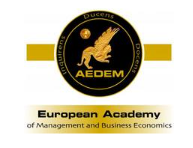Digital transformation and student satisfaction at the Autonomous University of Chile
DOI:
https://doi.org/10.35564/jmbe.2024.0013Keywords:
digital transformation, higher education, student satisfaction, loyalty, structural equationAbstract
The great advances that derive from the technological revolution 4.0 have permeated higher education institutions, which have been forced to initiate extensive transformation processes that consider the integration of digital technologies to guarantee student satisfaction, maintain their social validity and ensure their sustainability. In this article, focused on the case of the Autonomous University of Chile, the existence of causal relationships between the Digital Transformation model of that University and the Student Satisfaction Index model proposed by Turkyilmaz, Temizer and Oztekin (2018) is demonstrated. The objective of the research was to determine the impact of the digital transformation on the student’s satisfaction of that University. The structural equation modeling technique was applied, using the data obtained from a questionnaire applied to 313 students at that University in the month of May 2023. The analyzes carried out empirically validated the proposed theoretical model, demonstrating that perceived quality is the variable that has the greatest effect on student satisfaction, and finding that the expectations created regarding the results of the digital transformation of the University have a negative influence on the satisfaction; In other words, the higher the expectations about digital transformation, the more difficult it will be to satisfy students and achieve their loyalty to the institution.
Downloads
References
Al-Omari, Z. S., Alomari, K. A. A., & Aljawarneh, N. M. (2020). The role of empowerment in improving internal process, customer satisfaction, learning and growth. Management Science Letters, 841-848. https://doi.org/10.5267/j.msl.2019.10.013
Batista-Foget, J. M., & Coenders, G. (2000). Modelos de ecuaciones estructurales. Modelos para el análisis de relaciones causales. Arco Libros - La Muralla.
Bianchi, I. S., & Sousa, R. D. (2016). IT Governance Mechanisms in Higher Education. Procedia Computer Science, 100, 941-946. https://doi.org/10.1016/j.procs.2016.09.253
Catlin, T., Scanlab, J., & Willmott, P. (2015, June 1). Raising your Digital Quotient | McKinsey. McKinsey Company. https://www.mckinsey.com/capabilities/strategy-and-corporate-finance/our-insights/raising-your-digital-quotient#/
Crespo, B., & Pariente, E. (2018). Barómetro sobre la madurez digital en España 2018. https://circulodeempresarios.org/transformacion-digital/wp-content/uploads/PublicacionesInteres/11.barometro-madurez-digital-espana-2018.pdf
Demirkan, H., Spohrer, J. C., & Welser, J. J. (2016). Digital Innovation and Strategic Transformation. IT Professional, 18(6), 14-18. https://doi.org/10.1109/MITP.2016.115
Furedi, F. (2011). The Objectification of Fear and the Grammar of Morality. In Moral Panic and the Politics of Anxiety (pp. 90-103). Routledge. https://doi.org/10.4324/9780203869727
Gobble, M. M. (2018). Digitalization, Digitization, and Innovation. Research-Technology Management, 61(4), 56-59. https://doi.org/10.1080/08956308.2018.1471280
Kelly, K. (1999). New Rules for the New Economy: 10 Radical Strategies for a Connected World. Fourth Estate.
Krasota, T., Lisienko, S., Bedrina, S., Firsova, E., & Bazhenov, R. (2020). Technological Dynamism And Digital Transformation Of Modern Economics. 1443-1449. https://doi.org/10.15405/epsbs.2020.10.05.190
Lloret-Segura, S., Ferreres-Traver, A., Hernández-Baeza, A., & Tomás-Marco, I. (2014). El análisis factorial exploratorio de los ítems: Una guía práctica, revisada y actualizada. Anales de Psicología / Annals of Psychology, 30(3), Article 3. https://doi.org/10.6018/analesps.30.3.199361
Lorenzo, O. (2016). Modelos de Madurez Digital: ¿en qué consisten y qué podemos aprender de ellos? Boletín de Estudios Económicos, LXXI. https://www.researchgate.net/profile/Oswaldo-Lorenzo/publication/313798566_Modelos_de_Madurez_Digital_en_que_consisten_y_que_podemos_aprender_de_ellos/links/58a6b84aaca27206d9a7b3df/Modelos-de-Madurez-Digital-en-que-consisten-y-que-podemos-aprender-de-ellos.pdf
Martínez-Caro, E., Cegarra-Navarro, J. G., & Alfonso-Ruiz, F. J. (2020). Digital technologies and firm performance: The role of digital organisational culture. Technological Forecasting and Social Change, 154, 119962. https://doi.org/10.1016/j.techfore.2020.119962
Muehlburger, M., Rückel, D., & Koch, S. (2019). A Framework of Factors Enabling Digital Transformation. Americas Conference on Information Systems. https://www.semanticscholar.org/paper/A-Framework-of-Factors-Enabling-Digital-Muehlburger-R%C3%BCckel/93be7eff8a9ae2da441899164f8803a1c64c47a9
Mulaik, S. A. (2010). Foundations of factor analysis (2nd ed). CRC Press. https://doi.org/10.1201/b15851
Ortiz-Pérez, A., Funzy-Chimpolo, J. M., Pérez-Campaña, M., & Velázquez-Zaldívar, R. (2015). La gestión integrada de los procesos en universidades. Procedimiento para su evaluación. Ingeniería Industrial, 36(1), 91-103. http://scielo.sld.cu/scielo.php?script=sci_abstract&pid=S1815-59362015000100010&lng=es&nrm=iso&tlng=es
Parker, L. D. (2013). Contemporary University Strategising: The Financial Imperative. Financial Accountability & Management, 29(1), 1-25. https://doi.org/10.1111/faam.12000
Pérez-Gil, J. A., Chacón, S., & Moreno, R. (2000). Validez de constructo: El uso de análisis factorial exploratorio-confirmatorio para obtener evidencias de validez. Psicothema, 12(2), 442-446. https://www.psicothema.com/pdf/601.pdf
Pousttchi, K., Gleiss, A., Buzzi, B., & Kohlhagen, M. (2019). Technology Impact Types for Digital Transformation. 2019 IEEE 21st Conference on Business Informatics (CBI), 487-494. https://doi.org/10.1109/CBI.2019.00063
Rodríguez-Abitia, G., Martínez-Pérez, S., Ramirez-Montoya, M. S., & Lopez-Caudana, E. (2020). Digital Gap in Universities and Challenges for Quality Education: A Diagnostic Study in Mexico and Spain. Sustainability, 12(21), Article 21. https://doi.org/10.3390/su12219069
Rossmann, A. (2019). Digital Maturity: Conceptualization and Measurement Model. Bridging the Internet of People, Data, and Things. 2, 13-16. https://www.researchgate.net/publication/345760193_Digital_Maturity_Conceptualization_and_Measurement_Model
Ruiz, M. (2000). Introducción a los modelos de ecuaciones estructurales. In Madrid, UNED. Universidad Nacional de Educación a Distancia.
Salinas, J., & Vio, F. (2011). Programas de salud y nutrición sin política de Estado: El caso de la promoción de salud escolar en Chile. Revista Chilena de Nutrición, 38(2), 100-116. https://doi.org/10.4067/S0717-75182011000200001
Salisu, Y., & Abu Bakar, L. J. (2019). Technological capability, relational capability and firms' performance: The role of learning capability. Revista de Gestão, 27(1), 79-99. https://doi.org/10.1108/REGE-03-2019-0040
Sánchez, A., & Fernández, M. P. (2010). Informe Generación 2.0 2010: Hábitos de los adolescentes en el uso de las redes sociales. Estudio comparativo entre Comunidades Autónomas. Universidad Camilo José Cela. https://www.observatoriodelainfancia.es/ficherosoia/documentos/2824_d_generacin2-0-100706100017-phpapp01.pdf
Teichert, R. (2019). Digital Transformation Maturity: A Systematic Review of Literature. Acta Universitatis Agriculturae et Silviculturae Mendelianae Brunensis, 67(6), 1673-1687. https://doi.org/10.11118/actaun201967061673
Thompson, B. (2004). Exploratory and confirmatory factor analysis: Understanding concepts and applications. American Psychological Association. https://doi.org/10.1037/10694-000
Turkyilmaz, A., Temizer, L., & Oztekin, A. (2018). A causal analytic approach to student satisfaction index modeling. Annals of Operations Research, 263(1), 565-585. https://doi.org/10.1007/s10479-016-2245-x
Valdez-de-Leon, O. (2016). A Digital Maturity Model for Telecommunications Service Providers. Technology Innovation Management Review, 6(8). https://doi.org/10.22215/timreview/1008
Vrielink, R. O., Nijhuis-Boer, V., Van Horne, C., Hans, E., & Van Hillegersberg, J. (2019). A Framework for Planning and Control of the Education Organization. In V. L. Uskov, R. J. Howlett, L. C. Jain, & L. Vlacic (Eds.), Smart Education and e-Learning 2018 (Vol. 99, pp. 234-245). Springer International Publishing. https://doi.org/10.1007/978-3-319-92363-5_22
Wade, M., & Shan, J. (2020). Covid-19 Has Accelerated Digital Transformation, but May Have Made it Harder Not Easier. MIS Quarterly Executive, 19(3). https://doi.org/10.17705/2msqe.00034
Warner, K. S. R., & Wäger, M. (2019). Building dynamic capabilities for digital transformation: An ongoing process of strategic renewal. Long Range Planning, 52(3), 326-349. https://doi.org/10.1016/j.lrp.2018.12.001

Downloads
Published
How to Cite
Issue
Section
License
Copyright (c) 2024 Journal of Management and Business Education

This work is licensed under a Creative Commons Attribution-NonCommercial-ShareAlike 4.0 International License.
License terms at: https://creativecommons.org/licenses/by-nc/4.0/legalcode



